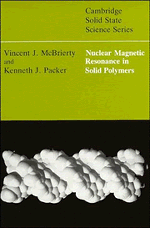Book contents
- Frontmatter
- Contents
- Preface
- Acknowledgements
- Glossary of terms
- 1 The NMR of solid polymers: an overview
- 2 Basic concepts in NMR
- 3 Nuclear spin interactions
- 4 Experimental methods
- 5 Structure and motion in solid polymers
- 6 Structural heterogeneity in polymers
- 7 Oriented polymers
- 8 Selected topics
- Appendix 1 Data on common polymers
- Appendix 2 The rotation operator
- Appendix 3 Rotation of tensors between coordinate frames
- Appendix 4 Spatial distribution of structural units in a polymer
- Appendix 5 The internal Hamiltonian
- Appendix 6 Spectral lineshapes
- Appendix 7 Analysis of spinning sidebands
- Bibliography
- References
- Author index
- Subject index
1 - The NMR of solid polymers: an overview
Published online by Cambridge University Press: 19 October 2009
- Frontmatter
- Contents
- Preface
- Acknowledgements
- Glossary of terms
- 1 The NMR of solid polymers: an overview
- 2 Basic concepts in NMR
- 3 Nuclear spin interactions
- 4 Experimental methods
- 5 Structure and motion in solid polymers
- 6 Structural heterogeneity in polymers
- 7 Oriented polymers
- 8 Selected topics
- Appendix 1 Data on common polymers
- Appendix 2 The rotation operator
- Appendix 3 Rotation of tensors between coordinate frames
- Appendix 4 Spatial distribution of structural units in a polymer
- Appendix 5 The internal Hamiltonian
- Appendix 6 Spectral lineshapes
- Appendix 7 Analysis of spinning sidebands
- Bibliography
- References
- Author index
- Subject index
Summary
The nature of polymers
One of the remarkable features of current progress in materials technology is the ever-increasing ability to control and design the physical and chemical responses of synthetic polymers. An unprecedented range of properties is now routinely accessible through a variety of processing techniques which include chemical synthesis and substitution, thermal and electrical treatment, addition of fillers, blending of dissimilar polymers and mechanical deformation to name but a few.
Polymers are long chain molecules comprising large numbers of basic repeat units: the chemical structures of some of the more common types are furnished in table A1.1 (Appendix 1). For the most part, they are organic materials of high molecular weight in crystalline, glassy or rubbery states, one or more of which may be simultaneously present. Attempts to understand more fully the underlying reasons behind the properties of polymers are bedevilled by a characteristically complex morphology which defies precise description even in the chemically simplest cases. There is concomitant complexity too in the way in which polymer molecules move. Motions of flexible backbone chains, for example, derive from many coupled degrees of freedom and there is often a broad distribution of spectral frequencies associated with a given motional event. Two or more discrete motions may be active at the same time.
- Type
- Chapter
- Information
- Nuclear Magnetic Resonance in Solid Polymers , pp. 1 - 15Publisher: Cambridge University PressPrint publication year: 1993



